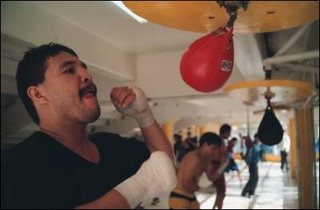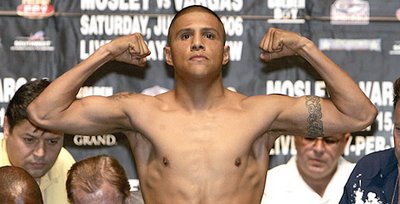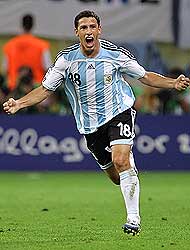 EJECTIONS OF USA PLAYERS SHOWS USA’S SOCCER CULTURAL DISCONNECT
EJECTIONS OF USA PLAYERS SHOWS USA’S SOCCER CULTURAL DISCONNECTKaiserslautern, Germany (June 17, 2006) - The USA barely survived an ejection filled match against historical and current soccer powerhouse Italy holding on for a 1-1 tie with 9 men on the field. After two American players were correctly ejected, incredulous USA coach Bruce Arena whined and complained on the sidelines at the referee, throwing up his arms in disgust, meanwhile American commentators on the ABC broadcast were also disgusted saying the ejections were wrong and even implying the match referee may have been bribed.
ABC soccer analyst Eric Wynalda: “Its clear that the (Pablo Mastroeni) ejection was done in retribution” (for the previous ejection of an Italian player for throwing an elbow at American forward Brian McBride).
ABC soccer analyst Alexi Lalas: “This was just another common tackle. The referee was too harsh.”
Referee Jorge Larrionda of Uruguay was simply following FIFA’s mandate to protect the integrity of talented players, reward technique and finesse over physical strength, rough and dangerous play and sheer slick cheating such as pulling jerseys, shoving and tripping. Most American players playing in MLS are used to playing under refereeing that protects the latter, but not the former.
ABC sports anchor Brent Musberger attacked the referee implying he may have been bribed or influenced saying that Larrionda was suspended back in 2002 by the Uruguayan Football Association for unspecified “irregularities.” That statement, true or false, has nothing to do with his calls during the game. Larrionda was right on protecting skilled, technical, and fair play.
MLS ALLOWS AND IMPLICITLY ENCOURAGES HARD PHYSICAL PLAYThe sad ejections of two American players that play in Major League Soccer, is the result of having a professional league that thrives on rough, physical play, where shoving, vicious tackles, shirt-pulling, muscling-up and overall frequent contact is allowed by the referees, condoned by coaches and ultimately indirectly endorsed by League officials.
Instead of bringing in players, coaches and soccer leaders from countries known for producing creative, technically gifted players and winning soccer philosophies and strategies, such as Brazil, Argentina, France, Holland and Portugal, MLS is a League dominated by American college players and coaches plus a handful of mediocre European soccer coaches and and third tier players from countries with soccer philosophies that have historically emphacized hard-nosed, physical play and power.

The result: boring, predictable, physical soccer. It is all about tackling and tackling hard, then tackle a bit harder. How about an elbow to the face, a bloody eye, now that is good, hard American sports action according to Commissioner Don Garber and his deputy Ivan Gazidis.
That is what MLS leaders think. That is what they think the American mainstream sports community: Good, manly, physical soccer that will surely dissipate the mainstream American sports community notion that soccer is “A game for girls.”
Want more proof?
For years, MLS has produced TV promo spots highlighting the MLS “Brand of Soccer” and inevitably one finds images of two players crashing hard and flying out into the sidelines, or a goalkeeper crashing against the post, a player with a bloody nose and a defender executing a vicious tackle against a forward.
Mr. Garber thinks those images can “sell soccer” to the mainstream American sports fan, that is to say, to “Joe NFL,” and “Mike Baseball.”
SOCCER SPECIFIC STADIUMS AND INTERNATIONAL STAFF AND VALUESSoccer-specific stadiums are indeed very important, but they are not the cure-all magic pill that will lead to business and sporting success. Sure, there are obvious advantages to League/club owned soccer stadiums, but at the end of the day it is all about the product on the field, respect for what the game means internationally, traditional values of the sport, true knowledge and understanding about what the game represents and of course, passion. That, combined with the solid business, logistics, technological and organizational resources
the League already has in place, is a recipe for success.
Are Mr. Garber and Mr. Gazidis going to wait until each and every single MLS team has its own soccer-specific stadium before they decide to fix the product on the field?
Boy, that is a long, long time to wait.MLS should stand for:
Multicultural League of Soccer. MLS should support a multicultural, World Cup like atmosphere from head to toe, diversity in coaching, players, in-stadium collateral entertainment (music, food, visuals), and diversity in soccer playing styles.
Where is the magic? Where is the creativity?
Things are changing but today, in MLS circles, coaches and American soccer “experts” (college players and coaches and retired MLS players) talk about players’ “work rate”, athleticism, strength and speed. They do not talk about creativity, vision, character, personality, and class, elements that international world class coaches and savvy lovers of the game focus on.
It is a cultural disconnect.
There are international soccer maxims that are revered and respected by soccer nations like Brazil, such as the notion of:
"Play and let play." Based on this principle, Brazilians allow the opponents to move the ball, to cross the midfield line and create plays putting pressure only when its necessary to defend themselves. This playing philosophy makes for a smooth, flowing game, where both teams have a chance to show their talents and provide a more entertainment and showmanship. MLS plays under an entirely different philosophy:
"Whack and let whack." Now there is a place for that and a name for that: boxing, wrestling or Mr. Garber's former employer, the NFL, but surely not professional soccer.
By taking corrective action, MLS would not only capture the interest of America's fastest growing commmunity, U.S. Latinos and other soccer-loving minority communities like European expats, Portuguese-Americans, immigrants from Korea, and many other non-Latino countries, but also their primary target audience: the suburban soccer community (plus a significant number of curious crossover mainstream fans from baseball, the NFL and basketball curious to see what is causing so much excitement).
TAB RAMOS SHOULD BE MLS COMMISSIONERName a commissioner with soccer credibility and international standing and multilingual and multicultural skills like Tab Ramos, Marcelo Balboa or Teofilo Cubillas, or former U.S. national team coach Steve Sampson. The commissioner is the voice of the League and Mr. Garber's voice is the voice of marketing jargon, of robotic responses about "expansion" and "TV ratings aspirations" and about "ticket sales."
Bring in more foreign players and coaches from places where creative soccer is played: Brazil, Argentina, France, Holland, Portugal, Africa.
Expand number of foreign player slots to 5 per team, with no limit on players from the CONCACAF area.
Mr. Garber: Your job is NOT to serve as a feeder for the U.S. national team hoping and praying they win the World Cup and magically bring instant credibility and success for MLS.
No, Sir.
Your job is to
make MLS one of the most exciting, world class leagues in the world. Sure, you must and should develop American players, but not at the expense of the entertainment value for the fans or prospective fans. You can still develop a fair number of American players if you increase the number of foreign player slots to 5 and add world class foreign coaches. It is not a contradiction, quite the opposite, by adding more world class players and coaches, the American players will develop faster.
MLS SHOULD BRING “THE WORLD’S GAME” TO AMERICA NOT ATTEMPT TO “AMERICANIZE” AND NEUTER ITBring multiculture to the stadiums, celebrate it, encourage it. Remember soccer is the "world's game". MLS should be about bringing the World's Game to America. Not about Americanizing the world's game neutering it and making it dull and clinical and sterile, or as former MLS player Luis Hernandez of Mexico, said:
"MLS soccer is like eating a potato without salt."MLS needs tons of salt and tons of spice and color.
###










